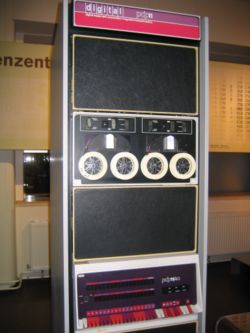Difference between revisions of "PDP-11/40"
From Computer History Wiki
(Shuffled around to improve rendering.) |
|||
| Line 1: | Line 1: | ||
| − | |||
| − | {{Infobox Machine| | + | |
| − | + | {{Infobox Machine | |
| − | + | | name=PDP-11/40 | |
| − | + | | image=Pdp-11-40.jpg | |
| − | + | | caption=PDP-11/40 with [[TU56]] dual [[DECtape]] drive. | |
| − | + | | manufacturer=[[Digital Equipment Corporation]] | |
| − | + | | word size= 16 bit | |
| − | + | | virtual address= 16 bit | |
| − | + | | physical address= 18 bit | |
| + | | bus arch= [[UNIBUS]]| | ||
|}} | |}} | ||
The PDP-11/40, introduced in 1973, was the first machine to introduce 18-bit memory addressing on the PDP-11 platform. | The PDP-11/40, introduced in 1973, was the first machine to introduce 18-bit memory addressing on the PDP-11 platform. | ||
| + | {{stub}} | ||
[[Category:DEC processors]][[Category:UNIBUS processors]] | [[Category:DEC processors]][[Category:UNIBUS processors]] | ||
Revision as of 03:04, 16 May 2007
| PDP-11/40 | |
 PDP-11/40 with TU56 dual DECtape drive. | |
| Manufacturer: | Digital Equipment Corporation |
|---|---|
| Word Size: | 16 bit |
| Physical Address Size: | 18 bit |
| Virtual Address Size: | 16 bit |
| Bus Architecture: | UNIBUS |
The PDP-11/40, introduced in 1973, was the first machine to introduce 18-bit memory addressing on the PDP-11 platform.